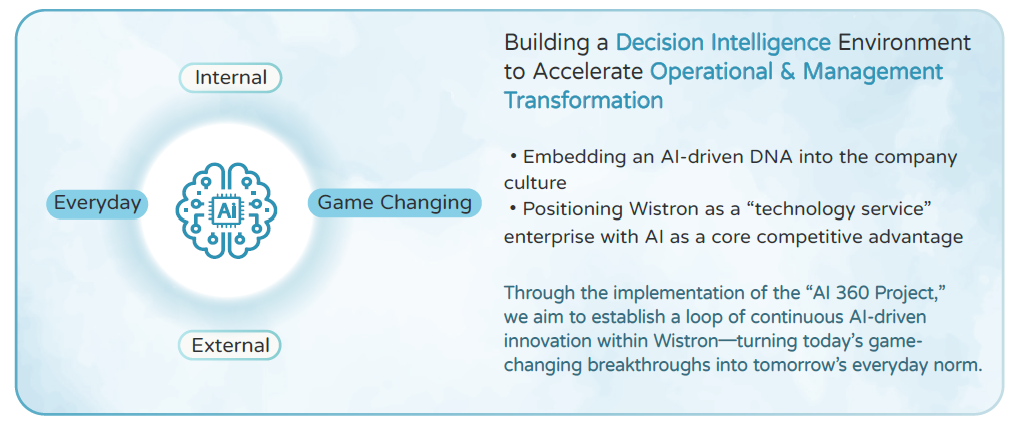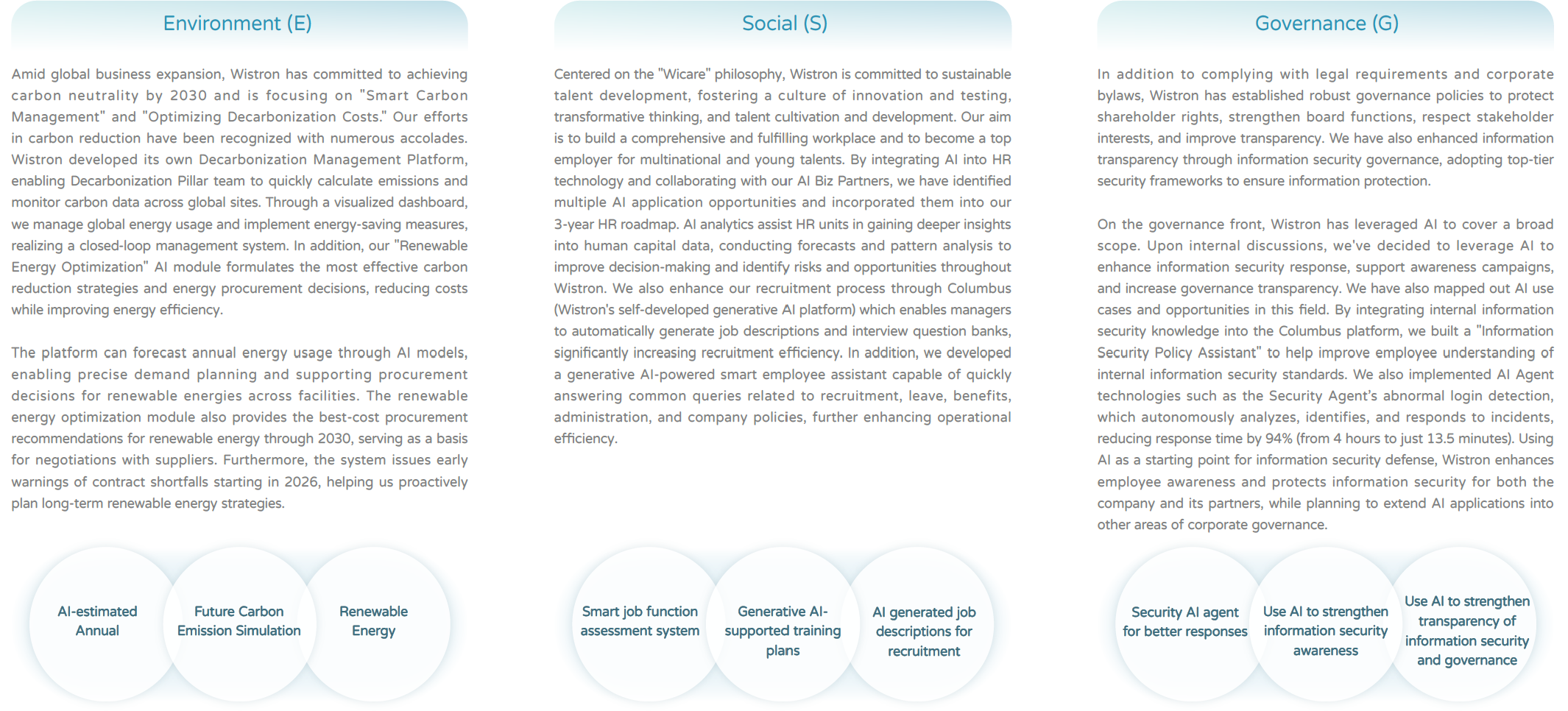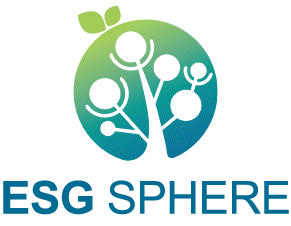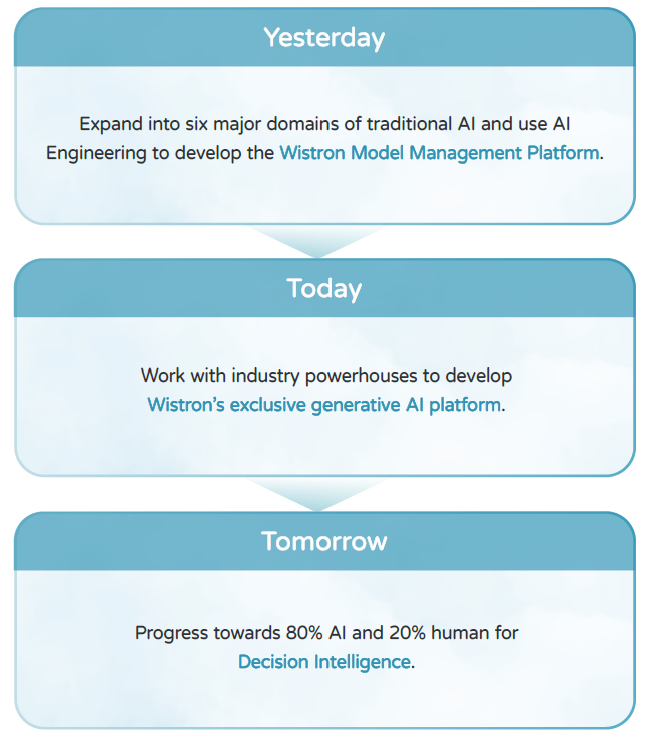AI-Driven Digital Transformation
Wistron operates 25 global locations and employs nearly 50,000 people, with a broad scope of business. In the face of global supply chain shifts and the rise of new manufacturing hubs, we are building on our foundation of digitization and automation to evolve from “digital transformation” to “smart transformation.” Our entire workforce is dedicated to strengthening core AI capabilities to meet market changes and customer needs, enabling seamless global collaboration and intelligent decision-making, and enhancing our organizational resilience and smart operations.
Guided by a vision of innovation and sustainability, Wistron is establishing a top-down unified AI development framework across the company, investing in the latest technologies for research and application. This not only drives a transformation in operational management but also embeds AI into Wistron’s DNA, making it a part of our daily operations. Through the AI 360 Project, we have accumulated approximately 70 AI innovation use cases from 2022 to 2024, generating NT$450 million in financial benefits and helping Wistron maintain a competitive edge.
In today’s industries, AI is undoubtedly the focus. According to a McKinsey & Company survey, 75% of the world's top CEOs recognize AI's impact on businesses. However, the World Economic Forum notes that 70% of enterprises remain in the exploratory phase when applying AI. This is largely because most companies approach AI with a fragmented mindset, lacking a comprehensive strategy across organization, process, technology, and talent. To fully realize AI’s synergistic potential, companies must adopt a comprehensive multi-dimensional perspective.

Three Core Pillars + Four Innovation Strategies
In an era of digital transformation and AI-driven innovation, Wistron is committed to building smart operations management to enhance competitiveness and create long-term value. We promote AI development and applications under the guiding principles of Three Core Pillars: “Unified Vision, Holistic Insight, and Comprehensive Consideration,” while advancing four innovation strategies: "Organization, Process, Technology, and Talent," all with a strong emphasis on safety and performance.
Three Core Pillars
| Unified vision | Top-down leadership by senior executives combined with bottom-up cross-department co-creation |
| Holistic insight | Integration of inside-out and outside-in perspectives |
| Comprehensive consideration | Emphasis on both the business value of AI and ethics and safety |
Four Innovation Strategies
| Organization | Establish a cross-functional AI Center of Excellence (CoE) led by top executives |
| Process | Define a management process from AI Lab (innovation pilot) to AI Factory (scalable deployment) and implement robust AI governance to ensure responsible AI aligns with corporate governance |
| Technology | Collaborate with global benchmarks, stay on top of cutting-edge trends, and build Wistron’s proprietary AI platform |
| Talent | Develop AI competencies across all levels, from the CEO to front-line employees, and create the new role of AI Business Partner (AI Biz Partner) |
Driving Innovation with Technological Breakthroughs
| In-house Development of Wistron GPT for Smart Corporate Applications |
|
| Generative AI Enables Smart Output for Complex Product Design - A Breakthrough for the ODM/OEM Industry |
|
Driving Process Innovation with Refined Approaches
| A Comprehensive Strategic Framework for AI-Driven Virtual-Physical Integration |
|
| Dedicated AI Biz Partner Teams Identify Opportunities Beyond Fragmented Thinking |
|
Panorama of AI Impact
Since 2022, Wistron has implemented approximately 70 AI projects. By driving advancements across organization, processes, technology, and talent, Wistron has successfully achieved smart management within a large and complex operational system, creating significant value for both the company and our customers.
AI-Driven Transformation of Work
Wistron employees actively embrace AI technology, which has brought forth innovative and efficient work models. Our self-developed generative AI platform, Columbus, integrates 28 proprietary business knowledge bases to enhance response accuracy. We also conduct monthly satisfaction and usage analyses to drive continuous improvement. Additionally, we have promoted the use of AI-powered coding tools and plan to expand adoption to 80% of our software developers. Empowered by these AI tools and mindsets, Wistron is gradually shifting from a work model of 20% AI + 80% manual effort to 80% AI + 20% manual effort in key areas, significantly improving overall efficiency at Wistron.
Embedding AI into Wistron’s DNA
Wistron is committed to embedding AI thinking into the daily habits of every employee, enabling a deep cultural transformation. From the outset, we established a clear goal and determination to operate independently and have implemented systematic measures to drive comprehensive AI integration.
By introducing and standardizing structured approaches, Wistron has built a collaborative ecosystem comprising the AI CoE (Center of Excellence), AI Biz Partners, AI Lab (for innovation and experimentation), and AI Factory (for deployment and scaling). This ecosystem facilitates deep integration of AI with business functions, ensuring that AI continuously and sustainably drives business development.
In just a short time, Wistron successfully transitioned from external support to internal autonomy and has operated maintained reliable AI operations for nearly two years. Today, teams across business units are able to respond to challenges with an AI-first mindset, demonstrating Wistron's resolve and success in AI applications and reforming workplace culture. Notable outcomes include software developers regularly using Copilot for code generation and review, and the company-wide “Low Code / No Code – Citizen Data Scientist” program having completed its 10th cohort with over 800 participants trained. A wide range of AI-related activities continue to evolve and expand, gradually establishing an AI-driven DNA throughout the organization.
Empowering ESG with AI

Digital Transformation in Patent Strategy
Wistron is committed to R&D and innovation. In addition to patent portfolios for emerging technologies, our digital transformation team has filed a total of 131 patent applications since 2021, safeguarding the outcomes of our technological innovations.
The use of AI in energy-related applications has also become an emerging trend. From the perspective of factory energy usage, AI technology is leveraged across three dimensions to achieve sustainable and efficient energy utilization:
- Equipment: AI provides suggestions and support with energy consumption optimization by adjusting operational parameters, improving maintenance routines, and replacing outdated equipment. Several related patents have been filed, including "Energy-Saving Prediction Method for Electricity Usage," "Smart Recommendations for Equipment Replacement Based on Energy Efficiency," and "Smart Recommendations for Maintenance Equipments."
- Management: AI supports the custom establishment of energy baselines and enables proactive alerts, real-time adjustments, and future scenario simulations. These capabilities allow effective comparisons between actual energy usage and baselines, providing effective suggestions for adjustments and optimization.
- Strategy: To achieve Wistron’s 2030 carbon neutrality target, AI assists in evaluating the cost-performance of renewable energy around the world, integrating strategy, cost, and carbon reduction goals. The optimization technology supports scenario modeling and simulation to inform renewable energy deployment and risk assessments. To protect these innovations, Wistron has filed patents such as "Optimization and Recommendation System for Renewable Energy Procurement."
Strengthening AI Governance with Responsible AI
The emergence of generative AI has brought immense opportunities, boosting productivity and creativity across organizations. At the same time, Wistron remains mindful of the associated risks and continues to enhance our AI governance mechanisms. Our goal is to ensure that AI delivers maximum value with minimal risk through a responsible AI approach.
To bolster AI governance, in 2024 Wistron focused on four key areas:
- Research on Regulations, Standards, and Global/Domestic Trends: We’ve conducted in-depth studies on AI-related regulations, including the EU Artificial Intelligence Act, the U.S. Executive Order on the Safe, Secure, and Trustworthy Development and Use of Artificial Intelligence, China’s Interim Measures for the Management Generative AI Services, and Taiwan’s AI Product and System Evaluation Guidelines. In parallel, we examined global standards and frameworks such as the NIST AI Risk Management Framework and ISO 42001 AI Management System. These efforts ensure that our governance mechanisms align with international standards and emerging global trends.
- Process Control Enhancements: We reviewed current AI use cases across model management, development and operations, and data governance, and incorporated information security principles and mechanisms into operational procedures.
- Seed Employee Training: We designated key personnel to undergo external training on the ISO 42001 AI Management System. This multi-role participation helps foster a shared vocabulary and effective communication across project teams, enabling efficient project execution.
- Initial Design of the Wistron AI Governance Framework: Based on our external research and internal assessments, we developed the foundation of Wistron’s AI governance framework, which is structured around four pillars: organization, talent, processes, and tools.
AI Sustainability and Future Roadmap
The journey from digital transformation to AI development is one of continuous evolution. To strengthen Wistron’s core AI competitiveness and accelerate our transition into a technology service enterprise, our 2024 focus is on driving more E2E game-changing use cases. These efforts emphasize advancements in generative AI, particularly multi-modal capabilities and AI Agents, as well as virtual-physical integration. We are actively shaping the next chapter of AI at Wistron by deepening AI adoption across internal operations and fostering a robust AI ecosystem through partnerships with internal and external partners to strengthen our cooperation with customers, suppliers, and tech leaders.
To ensure smooth execution, we conduct weekly progress reviews, host monthly exchanges with the CIO and CDO for strategic guidance, and hold quarterly executive briefings with the President and business group heads to align on major directions. This ensures that AI applications play a long-term and critical role in Wistron's long-term development as we advance on a sustainable path grounded in truth, goodness, and beauty, with AI as a catalyst for meaningful change.
Innovation and Differentiation
Wistron's key to successful AI adoption lies in our willingness to break away from traditional approaches, inspiring all employees to dream boldly while formulating clear strategies to achieve innovation and differentiation. We actively explore AI opportunities, advancing from traditional AI toward generative AI, with a firm focus on our goals for the next three years to ensure steady progress in our innovation journey.








